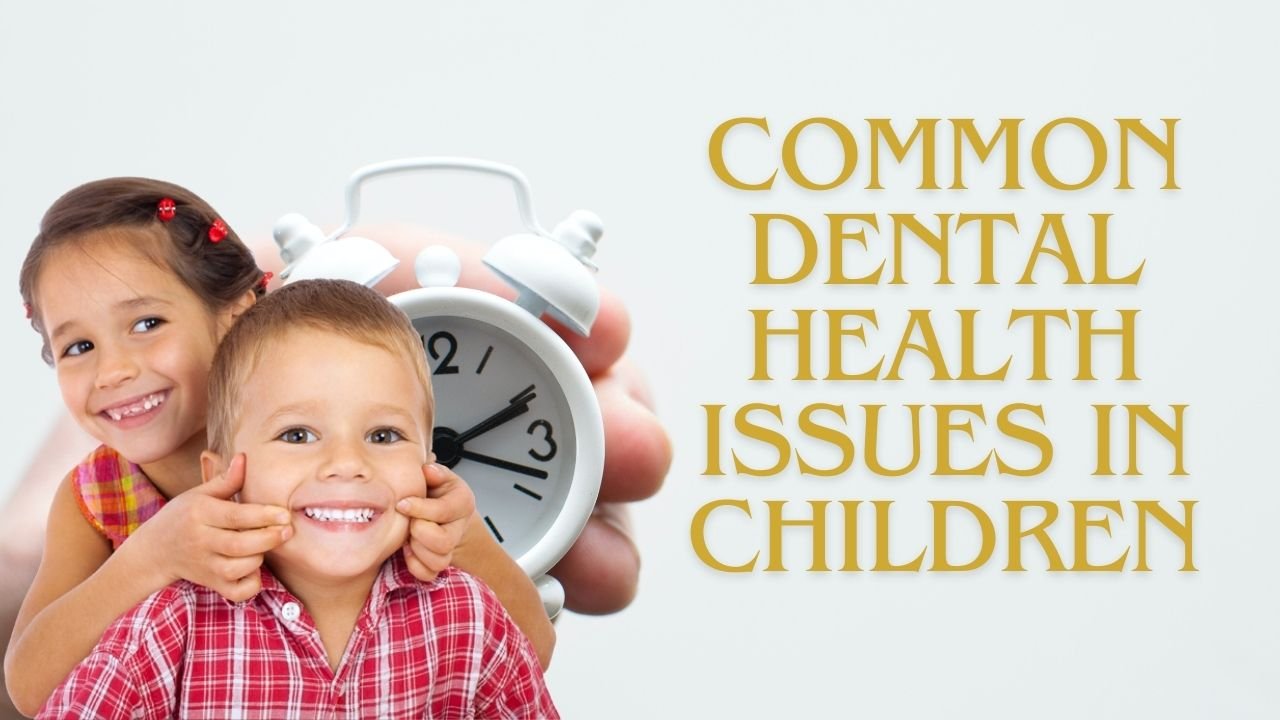In this article, we will discuss some of the common dental health issues in children, their causes, and how to prevent them. Dental health is an important aspect of overall health, and it is essential to maintain good oral hygiene from an early age. Children are particularly susceptible to dental health issues due to various factors such as lack of proper dental care, poor diet, and inadequate oral hygiene habits.
The Few Common Dental Health Issues In Children
1. Tooth Decay
Tooth decay is one of the most common dental health issues in children. It occurs when bacteria in the mouth break down sugars and produce acid that erodes the tooth enamel, leading to cavities. Tooth decay is more common in children because their tooth enamel is thinner and weaker than that of adults, making their teeth more vulnerable to decay.

Causes:
- Poor Oral Hygiene:
- Cause: Inadequate brushing and flossing allow bacteria to accumulate on teeth, forming plaque, which produces acids that erode tooth enamel.
- Prevention: Brush teeth twice a day with fluoride toothpaste and floss daily to remove plaque and prevent decay.
- Sugar and Carbohydrate Consumption:
- Cause: Sugars and carbohydrates in food and drinks are consumed by bacteria in the mouth, producing acids that contribute to enamel erosion.
- Prevention: Limit sugary and starchy foods and beverages, and practice good oral hygiene to reduce acid production.
- Acidic Foods and Drinks:
- Cause: Acidic foods and drinks (e.g., citrus fruits, sodas) can soften tooth enamel, making it more susceptible to decay.
- Prevention: Consume acidic items in moderation, and rinse your mouth with water afterward to neutralize acids.
- Dry Mouth:
- Cause: Reduced saliva flow (dry mouth) can impair the natural cleansing and neutralizing effects of saliva, leading to an increased risk of decay.
- Prevention: Stay hydrated, consider sugar-free gum or lozenges to stimulate saliva production, and address underlying causes of dry mouth.
- Poor Nutrition:
- Cause: A diet lacking in essential nutrients, particularly calcium and vitamin D, can weaken tooth enamel.
- Prevention: Maintain a balanced diet rich in nutrients important for oral health, including dairy products, leafy greens, and lean proteins.
- Bacterial Infection:
- Cause: Streptococcus mutans and other bacteria in the mouth produce acids that contribute to decay when given the opportunity.
- Prevention: Practice good oral hygiene to reduce bacterial load, and consider antibacterial mouthwashes as recommended by your dentist.
- Inadequate Fluoride:
- Cause: Insufficient fluoride exposure can weaken enamel and make teeth more susceptible to decay.
- Prevention: Use fluoride toothpaste, drink fluoridated water, and consider fluoride supplements or treatments as recommended by your dentist.
Prevention:
- Effective Oral Hygiene:
- Brush teeth with fluoride toothpaste for two minutes, twice daily, and floss daily to remove plaque and prevent decay.
- Balanced Diet:
- Consume a well-balanced diet with limited sugary and starchy foods. Include foods rich in calcium and vitamin D for strong enamel.
- Regular Dental Check-ups:
- Schedule regular dental exams and cleanings to detect and address early signs of decay. Professional cleanings help remove plaque and tartar.
- Fluoride Use:
- Use fluoride toothpaste and, if necessary, fluoride mouthwash or supplements as recommended by your dentist to strengthen enamel.
- Limit Snacking:
- Minimize between-meal snacking, as frequent snacking exposes teeth to acids for longer periods.
- Drink Water:
- Drink water throughout the day, especially after consuming acidic or sugary foods, to rinse away acids and sugars.
- Chewing Sugar-Free Gum:
- Chewing sugar-free gum after meals can stimulate saliva flow, which helps neutralize acids and cleanse the mouth.
- Sealants:
- Consider dental sealants, a protective coating applied to the chewing surfaces of molars, to prevent decay in vulnerable areas.
Preventing tooth decay involves a combination of good oral hygiene practices, a healthy diet, regular dental check-ups, and protective measures such as fluoride use and dental sealants. Consistent and proactive oral care is key to maintaining optimal dental health and preventing decay.
2. Gum Disease
Gum disease, also known as periodontal disease, is an infection of the gums that can lead to tooth loss if left untreated. It is caused by the buildup of plaque on the teeth, which can lead to inflammation and bleeding of the gums. Gum disease is more common in older children and teenagers.

Causes:
- Poor Oral Hygiene:
- Cause: Inadequate brushing and flossing lead to the buildup of plaque, a sticky film of bacteria on teeth. Over time, plaque hardens into tartar, contributing to gum disease.
- Prevention: Maintain thorough oral hygiene by brushing teeth twice daily and flossing to remove plaque.
- Tobacco Use:
- Cause: Smoking or using tobacco products increases the risk of gum disease by affecting blood flow to the gums and compromising the immune system.
- Prevention: Quit smoking or using tobacco to reduce the risk of gum disease and improve overall oral and general health.
- Poor Nutrition:
- Cause: A diet lacking in essential nutrients, particularly vitamin C, can weaken the immune system and contribute to gum disease.
- Prevention: Maintain a balanced diet with adequate nutrients, including fruits and vegetables rich in vitamin C.
- Medical Conditions:
- Cause: Conditions such as diabetes, autoimmune diseases, and certain blood disorders can increase the risk of gum disease.
- Prevention: Manage underlying medical conditions through proper treatment and regular monitoring.
- Hormonal Changes:
- Cause: Hormonal fluctuations, such as those during puberty, pregnancy, and menopause, can make gums more susceptible to inflammation and disease.
- Prevention: Practice good oral hygiene and seek professional dental care during hormonal changes.
- Genetic Predisposition:
- Cause: Genetic factors can play a role in an individual’s susceptibility to gum disease.
- Prevention: While genetics cannot be changed, regular dental check-ups and proactive oral care can help manage the risk.
- Medications:
- Cause: Certain medications, such as antihypertensive drugs and some anticonvulsants, may cause gum overgrowth (gingival hyperplasia) and increase the risk of gum disease.
- Prevention: Inform your dentist about all medications you are taking, and maintain excellent oral hygiene to counteract potential side effects.
Prevention:
- Effective Oral Hygiene:
- Brush teeth at least twice daily using fluoride toothpaste, and floss daily to remove plaque from between teeth and along the gumline.
- Regular Dental Check-ups:
- Schedule regular dental exams and cleanings to detect and address early signs of gum disease. Professional cleanings remove tartar buildup.
- Healthy Lifestyle Choices:
- Quit smoking or using tobacco products to reduce the risk of gum disease and improve overall health.
- Balanced Diet:
- Eat a well-balanced diet rich in fruits, vegetables, whole grains, and lean proteins to support overall oral and systemic health.
- Manage Stress:
- Chronic stress can contribute to gum disease. Practice stress-reducing activities such as exercise, meditation, or yoga.
- Manage Medical Conditions:
- Control underlying medical conditions, such as diabetes, through proper treatment and monitoring.
- Oral Health Education:
- Educate yourself about proper oral hygiene practices and follow your dentist’s recommendations for home care.
- Medication Management:
- If taking medications that may impact gum health, discuss potential side effects with your dentist and adjust oral care routines accordingly.
Preventing gum disease involves a combination of maintaining good oral hygiene, adopting a healthy lifestyle, and addressing potential risk factors through regular dental care and awareness. Early detection and intervention are key to managing and preventing the progression of gum disease.
3. Malocclusion
Malocclusion refers to the misalignment of teeth or the incorrect relation between the upper and lower teeth. It can lead to difficulty chewing and speaking, as well as self-esteem issues.

Causes:
- Genetic Factors:
- Cause: Malocclusion can be inherited, with genetics playing a significant role in the size and shape of the jaw, as well as the positioning of teeth.
- Prevention: While genetic factors are not preventable, early orthodontic intervention can help manage malocclusion.
- Thumb Sucking and Pacifier Use:
- Cause: Prolonged thumb sucking or pacifier use, especially beyond the age of 3, can impact the alignment of teeth and jaw development.
- Prevention: Discourage thumb sucking or pacifier use as children grow, and provide positive reinforcement when good habits are established.
- Premature Tooth Loss:
- Cause: Losing baby teeth prematurely without proper guidance for incoming permanent teeth can lead to malocclusion.
- Prevention: Encourage good oral hygiene to prevent tooth decay, and address dental issues promptly to avoid premature tooth loss.
- Impacted Teeth:
- Cause: Teeth that do not emerge properly, or impacted teeth, can disrupt the natural alignment of adjacent teeth.
- Prevention: Regular dental check-ups can help identify potential issues early, and timely intervention can prevent complications.
- Injuries or Trauma:
- Cause: Facial injuries or trauma to the jaw can result in malocclusion.
- Prevention: Use protective gear during sports activities and take precautions to prevent accidents that may cause facial trauma.
- Poor Oral Habits:
- Cause: Habits such as tongue thrusting, mouth breathing, or incorrect swallowing patterns can contribute to malocclusion.
- Prevention: Address poor oral habits early on, and consider consulting with a speech therapist or orthodontist for guidance.
- Tumor or Cyst Development:
- Cause: Uncommonly, the growth of tumors or cysts in the jaw area can impact tooth alignment.
- Prevention: Regular dental check-ups and prompt medical attention for any unusual symptoms can help identify and address such issues.
Prevention:
- Early Orthodontic Intervention:
- Early evaluation by an orthodontist can help detect and address potential alignment issues in children. Timely intervention can prevent more severe malocclusion.
- Maintain Good Oral Hygiene:
- Encourage and practice good oral hygiene to prevent tooth decay and the loss of baby teeth, which can affect the alignment of permanent teeth.
- Dental Check-ups:
- Regular dental check-ups allow for the early detection of issues that may contribute to malocclusion. Early intervention can prevent more significant problems.
- Address Oral Habits:
- Discourage thumb sucking, pacifier use, tongue thrusting, and other poor oral habits in children. Positive reinforcement can be helpful in breaking these habits.
- Protective Measures:
- Use protective gear, such as mouthguards, during sports activities to prevent facial injuries that may impact tooth alignment.
- Prompt Treatment of Dental Issues:
- Address dental problems promptly, including cavities and gum disease, to prevent premature tooth loss and subsequent malocclusion.
- Orthodontic Treatment:
- If malocclusion is detected, orthodontic treatment, such as braces or aligners, can help correct the alignment of teeth and jaws.
Preventing malocclusion involves a combination of early intervention, good oral hygiene practices, and addressing potential contributing factors. Regular dental check-ups are essential for monitoring dental development and addressing any issues promptly.
4. Oral Trauma
Oral trauma refers to any injury to the mouth, teeth, or gums. It can be caused by a variety of factors, including falls, sports injuries, and car accidents.
Causes:
Oral trauma can be caused by a variety of factors, including falls, sports injuries, and car accidents.
Prevention:
Prevention of oral trauma in children can be achieved by encouraging them to wear protective gear such as mouthguards while playing sports or engaging in other physical activities. Parents can also supervise their children to prevent falls and ensure they use seat belts while in the car.
5. Tooth Sensitivity
Tooth sensitivity can be caused by various factors, and preventing it often involves addressing the underlying causes. Here are some common causes and prevention strategies for tooth sensitivity:
Causes:
- Enamel Erosion:
- Cause: Acidic foods and beverages, frequent consumption of sugary foods, and gastroesophageal reflux disease (GERD) can lead to enamel erosion.
- Prevention: Limit acidic and sugary foods, maintain good oral hygiene, and consider using fluoride toothpaste to strengthen enamel.
- Gum Recession:
- Cause: Poor oral hygiene, aggressive brushing, or gum disease can cause the gums to recede, exposing the sensitive tooth roots.
- Prevention: Brush gently with a soft-bristled toothbrush, floss regularly, and treat gum disease promptly.
- Bruxism (Teeth Grinding):
- Cause: Grinding or clenching teeth, especially during sleep, can wear down enamel and cause sensitivity.
- Prevention: Use a mouthguard at night, manage stress, and consider relaxation techniques.
- Dental Procedures:
- Cause: Some dental procedures, such as teeth whitening or aggressive cleanings, can cause temporary sensitivity.
- Prevention: Follow post-procedure care instructions provided by your dentist.
- Cracked Teeth:
- Cause: Teeth can develop cracks or fractures due to injury or biting on hard objects.
- Prevention: Avoid biting on hard substances, and seek prompt dental care for any trauma or injuries.
Prevention:
- Good Oral Hygiene:
- Brush your teeth twice a day using a fluoride toothpaste.
- Floss daily to remove plaque and prevent gum disease.
- Use a Soft-Bristled Toothbrush:
- Choose a toothbrush with soft bristles to prevent enamel wear and gum recession.
- Limit Acidic Foods and Drinks:
- Reduce the consumption of acidic foods and beverages, such as citrus fruits and sodas.
- Mouthguard for Bruxism:
- If you grind your teeth, use a custom-fitted mouthguard, especially at night.
- Regular Dental Check-ups:
- Visit your dentist regularly for check-ups and professional cleanings.
- Fluoride Products:
- Use fluoride toothpaste and consider fluoride treatments recommended by your dentist.
- Avoid Teeth Whitening Abuse:
- If using teeth whitening products, follow instructions carefully to prevent sensitivity.
- Healthy Diet:
- Maintain a balanced diet rich in calcium and other nutrients for overall oral health.
If you experience persistent tooth sensitivity, it’s essential to consult with a dentist to determine the underlying cause and receive appropriate treatment.
6. Dental Anxiety
Dental anxiety is a common issue in children, particularly those who have had negative experiences at the dentist in the past. Children who are anxious about dental visits may be more likely to avoid dental care, which can lead to more significant dental problems over time.
Causes:
- Fear of Pain:
- Cause: Past negative dental experiences, especially those involving pain, can contribute to a fear of dental procedures.
- Prevention: Communicate openly with your dentist about any past traumatic experiences, and work together to establish a plan for managing pain and discomfort.
- Loss of Control:
- Cause: Some individuals feel anxious due to a perceived loss of control during dental procedures.
- Prevention: Establish a signal with your dentist to communicate when you need a break or feel uncomfortable. This can help you regain a sense of control during the appointment.
- Embarrassment or Shame:
- Cause: Concerns about the appearance of one’s teeth or fear of judgment can contribute to dental anxiety.
- Prevention: Recognize that dentists are professionals who are there to help, not to judge. Openly discuss your concerns with the dental team to create a supportive environment.
- Previous Traumatic Experiences:
- Cause: A history of trauma, whether related to dental care or not, can heighten anxiety.
- Prevention: Share your concerns with your dentist, and consider seeking support from a mental health professional if needed.
- Fear of Needles or Instruments:
- Cause: Fear of needles or dental instruments can contribute to anxiety.
- Prevention: Discuss these fears with your dentist, and explore alternative methods for managing discomfort, such as topical numbing gels.
Prevention:
- Open Communication:
- Establish open communication with your dentist. Share your fears and concerns so they can tailor their approach to make you more comfortable.
- Gradual Exposure:
- Gradually expose yourself to the dental environment. Start with short, non-invasive appointments to build trust and familiarity.
- Relaxation Techniques:
- Practice relaxation techniques, such as deep breathing or meditation, before and during dental appointments.
- Behavioral Therapy:
- Consider behavioral therapy or counseling to address underlying fears and anxieties.
- Sedation Options:
- Discuss sedation options with your dentist. Nitrous oxide (laughing gas) or oral sedation can help relax anxious patients.
- Choose a Supportive Dentist:
- Look for a dentist who specializes in treating anxious patients or who offers a calm and supportive environment.
- Bring a Support Person:
- Bring a friend or family member for support during appointments.
- Regular Dental Visits:
- Schedule regular preventive visits to the dentist to catch and address issues early, reducing the need for more extensive treatments.
Addressing dental anxiety requires a collaborative effort between the patient and the dental team. By openly communicating your fears and working with a supportive dentist, you can take steps towards managing and overcoming dental anxiety..
7. Enamel Hypoplasia
Enamel hypoplasia is a condition in which the tooth enamel is thinner than normal. It can be caused by a variety of factors, including malnutrition, premature birth, and certain medications. Enamel hypoplasia can make the teeth more susceptible to decay and sensitivity. Baby bottle tooth decay is a form of tooth decay that occurs in infants and young children who consume sugary liquids such as juice and milk from a bottle or sippy cup. Prolonged exposure to these liquids can cause decay in the front teeth.
Causes:
- Genetic Factors:
- Cause: Genetic factors can contribute to enamel hypoplasia, where individuals may inherit a predisposition to enamel defects.
- Prevention: While genetic factors are not preventable, early identification and intervention can help manage enamel hypoplasia.
- Maternal Factors During Pregnancy:
- Cause: Poor maternal nutrition, certain illnesses (such as rubella), or exposure to certain drugs during pregnancy can affect tooth development in the fetus.
- Prevention: Prenatal care and maintaining good maternal health during pregnancy can help reduce the risk of enamel hypoplasia in the developing teeth of the fetus.
- Childhood Illnesses:
- Cause: Illnesses such as high fevers, measles, chickenpox, or nutritional deficiencies during early childhood can disrupt enamel formation.
- Prevention: Ensure timely vaccinations, maintain good overall health, and provide a balanced diet to children to minimize the impact of illnesses on dental development.
- Trauma or Injury:
- Cause: Physical trauma to primary (baby) teeth or permanent teeth during their development can lead to enamel hypoplasia.
- Prevention: Take precautions to prevent injuries, and seek prompt dental care if a child experiences dental trauma.
- Fluoride Deficiency or Excess:
- Cause: Inadequate fluoride during tooth development or excessive fluoride intake during the same period can impact enamel formation.
- Prevention: Ensure appropriate fluoride levels through community water fluoridation or fluoride supplements, as recommended by dental professionals. Avoid excessive use of fluoride toothpaste in young children.
Prevention:
- Good Prenatal Care:
- Receive proper prenatal care, including a balanced diet and avoidance of harmful substances, to promote healthy tooth development in the fetus.
- Nutrition:
- Provide a well-balanced diet with adequate vitamins and minerals, particularly calcium and vitamin D, to support proper enamel development.
- Regular Dental Check-ups:
- Schedule regular dental check-ups for children to monitor dental development and detect any issues early on.
- Fluoride Supplementation:
- Follow dental recommendations for fluoride supplementation, especially in areas with suboptimal fluoride levels in drinking water.
- Preventive Oral Care:
- Practice good oral hygiene from a young age, including regular brushing and flossing, to maintain overall oral health.
- Avoidance of Harmful Substances:
- Encourage pregnant individuals to avoid smoking, excessive alcohol consumption, and certain medications that could negatively impact fetal tooth development.
- Protection Against Trauma:
- Take precautions to prevent injuries to primary and permanent teeth, especially during childhood and adolescence.
- Early Intervention:
- Seek prompt dental care if there are signs of enamel hypoplasia or other dental abnormalities. Early intervention can help manage and mitigate the impact of such conditions.
Enamel hypoplasia prevention primarily involves maintaining overall health and well-being during pregnancy, childhood, and adolescence, along with proper dental care and hygiene practices. Regular dental check-ups are essential for early detection and intervention.
Conclusion
In conclusion, addressing common dental health issues in children is paramount for their overall well-being. From preventing tooth decay through proper oral hygiene practices and a balanced diet to managing issues like malocclusion and enamel hypoplasia, early intervention and regular dental check-ups play a crucial role in promoting a lifetime of healthy smiles. Educating parents and caregivers about the importance of oral care, fostering positive dental habits in children, and seeking timely professional guidance are integral components of ensuring optimal dental health during the formative years. By focusing on prevention and early detection, we can pave the way for children to develop strong, healthy teeth and establish habits that will contribute to their long-term oral health.
















